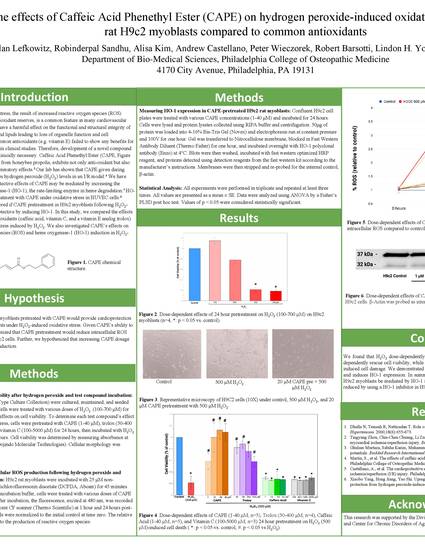
Caffeic Acid Phenethyl Ester (CAPE) is a natural compound that has previously exhibited anti-proliferative, anti-inflammation and antioxidant activities. However, CAPE’s effects have not been fully elucidated in myoblasts under oxidative stress. We compared the effects of 24 hour pretreatment of CAPE to several known antioxidants (caffeic acid, vitamin C, and trolox) in H9c2 cells following oxidative injury by hydrogen peroxide (H2O2). H9c2 cells incubated with H2O2 treatment (100-700 μM, n=4) for 24 hours dose-dependently reduced cell viability (assessed by a cell counting assay). Compared to the reduction in viability from H2O2 500 μM treatment (22 ± 4%), H9c2 cell viability was significantly restored by pretreatment of CAPE (at 10 μM (100 ± 25%); 20 μM (112 ± 15%); 40 μM (109 ± 15%) n=5, p<0.001) and Trolox (at 50 μM (83 ± 10%); 100 μM (89 ± 8%) n=4, p<0.001). In contrast, pretreatment of H9c2 cells with caffeic acid (1-80 μM, n=3) and vitamin C (1000-10,000 μM, n=3) did not restore cell viability following H2O2-induced injury. CAPE’s mechanism was further investigated by measuring reactive oxygen species via a dichlorofluorescin diacetate assay and by evaluating heme oxygenase-1 (HO-1) expression via western blot. Increases in ROS caused by H2O2 500 μM (239 ± 30% of control, n=3) were significantly restored to control by pretreatment of CAPE dose-dependently (n=3, p<0.001). Moreover, CAPE dose-dependently increased HO-1 expression (n=3). These results suggest CAPE can mitigate oxidative stress in H9c2 cells which may involve the induction of HO-1.
Available at: http://works.bepress.com/robert_barsotti/52/